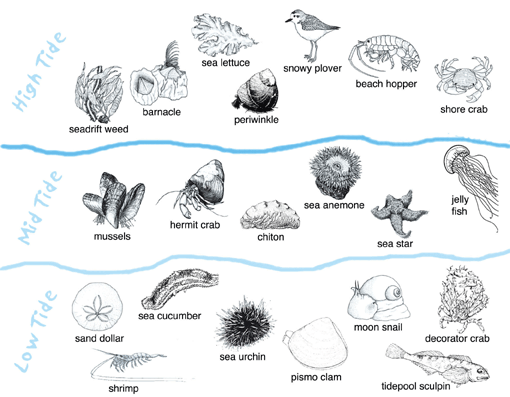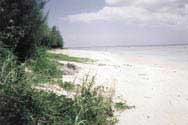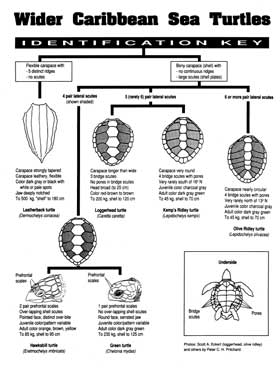|
|
Coastal region and small island papers 19
11
|
Green turtle (Chelonian |
 |
Background
While at a glance beaches may appear as barren stretches of sand, in reality they are diverse and productive transitional ecosystems that serve as a critical link between marine and terrestrial environments.
The sandy beach is an unstable environment for plants and animals, largely because the surface layers of the beach are in constant motion as a result of waves and wind. This also means that organisms that live there are specially adapted to survive well in this type of environment. Many burrow in the sand for protection from waves or to prevent drying out during low tide. Others are just visitors, such as birds and fishes. While different animals are found in different zones, they often move up and down the beach with tides. Hence, zonation patterns along sandy shores are not as clearly defined as on rocky shores.
 |
| Figure 23 Common plants and animals found between the high and low water mark. (Illustration compiled by Aurčle Clemencin) |
Observing and recording plants and animals on the beach
Collect, observe and
record
►
For this activity, give the students plastic bags and ask each of them to collect ten different objects from the beach and to record where on the beach each object was found. In addition you may also ask them to record five different plants they see and five different animals; if they cannot identify a particular plant or animal, suggest they make a sketch.
Identify the collected
items
►
Back in the classroom, get the students to separate biological from non-biological items, and plants from animals. Then ask them to identify the items in their collections. Once this has been completed and discussed, ask each student to select one of the plants or animals they collected and to describe it – shape, colour, size – and draw a picture of it. As a further activity, ask the students to research its habits – diet, movement, reproduction, protection – and note any unusual or interesting features. Include ways in which it might be affected by humans and how it might be protected.
Understand the beach
ecosystem
►
The beach ecosystem represents the interaction between the biological organisms and the physical environment in the beach area. Thus the birds and the crabs are as much a part of the ecosystem as the sand and the waves. Learning how the different components interact and depend on each other is the study of ecology.
Use the organisms collected on the beach to build a food chain to show how the various plants and animals interact within the ecosystem and how energy passes from one organism to another. Figure 24 shows a simple food chain.
| Sun
▼ Plants (producers) ▼ Plant eaters (herbivores) ▼ Meat eaters (carnivores) |
Sun ▼ Algae in coral and seagrass ▼ Parrot fish, Green turtle ▼ Sharks, Barracuda |
Figure 24
Simple food chain.
What to measure
Vegetation on the beach and behind the beach plays an important role in helping
to stabilize the beach and prevent
erosion.
Landward of the highest high water mark, vines and grass predominate and the sand runner or goat-foot (Ipomoea pes-caprae), a long trailing vine, is often found colonizing the sand surface. Other species of vines, herbs and shrubs occur in a landward direction. Further inland there are coastal trees, such as seagrape (Cocoloba uvifera), seaside mahoe (Thespesia populnea), coconut palms (Cocos nucifera), manchineel (Hippomane mancinella) and the West Indian almond (Terminalia catappa). The change from low vines and grasses to mature trees is known as a vegetation succession.
How to measure
►
Identify the vegetation succession at the beach. Lay out the tape measure
starting at the seaward edge of the vegetation and, at 2 yd (2 m) intervals,
note down the number of plant species present and identify them or describe them
if names are not known. Note particularly if any plants appear to be stressed,
e.g. roots exposed or brown leaves.
When to measure
What will the
measurements show
►
Use the data collected to try and develop a vegetation succession. A typical
coastal succession is shown in Figure 25. Discuss the environmental conditions
in the different zones, e.g. the frontal zone may be subject to wave action
during storms and will receive the full force of the salt spray (or sea blast),
while the forest zone may be more protected from the salt spray and the wind,
and the soil and nutrient conditions may be better.
Then ask the students to forecast what would happen to the beach environment if all the vegetation was removed for a new development project such as a 100+ room hotel complex.
 |
Figure 25 |
| ▲
Vegetation succession, Rarotonga, Cook Islands, 2003. Here the grasses and vines give way almost immediately to the coastal woodland. |
 |
What to measure
►
Many tropical sandy beaches are used for nesting by sea turtles. The most common species are:
Leatherback
turtle (Dermochelys coriacea)
Hawksbill turtle (Eretmochelys imbricata)
Green turtle (Chelonia mydas)
Loggerhead turtle (Caretta caretta)
Kemp’s Ridley turtle (Lepidochelys kempii)
Olive Ridley turtle (Lepidochelys olivacea)
At night-time, female turtles come up onto the beach, make nests at the back of the beach or in the vegetation behind the beach and lay their eggs in the sand. The period for nesting differs according to the species and the geographical area of the world. After the eggs have been laid, the female covers the nest with sand and returns to the sea. Between 55 and 72 days later the hatchlings emerge and make their perilous journey down the beach to the sea.


Figure 26
Sea turtle identification. (Source:
WIDECAST, 1991)
(See also Annex 4, to reproduce for classroom purposes.)
 |
 |
|
| Turtle tracks at Long Beach,
Ascension Island, February 2004. |
Safeguarding a
turtle nest on a |
Many of these turtles are endangered because of over-harvesting in the past, and many countries have programmes to conserve marine turtles and their eggs.
Monitoring may consist of
night-time watches at key nesting beaches, monitoring beaches early
in the morning for evidence of turtle tracks and monitoring nesting
activity for emerging hatchlings.
How to get involved in monitoring
Observing turtle nesting at night, from a safe distance so as not to disturb the female turtle, can be a very exciting experience; as is monitoring the nest to see the hatchlings emerge and make their journey to the sea.
In some areas, key turtle nesting beaches are
monitored during the turtle nesting season to observe and record turtle
tracks and evidence of successful nesting.
Follow-up activities
If students take part in any aspect of turtle monitoring, there are many areas where they can conduct further work and research; here are just a few ideas:
-
Conduct research to find out which turtle species nest in your country and how many successful nests are laid. Compare these figures with historical information.
-
Why are sea turtles endangered and what threats do they face?
-
What can you do to help conserve marine sea turtles?